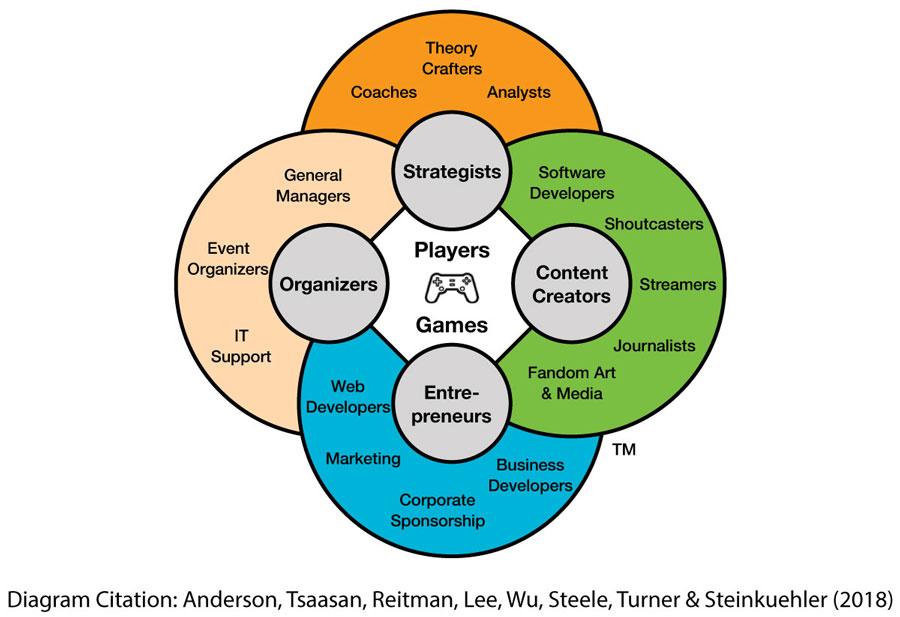Esports and Student Success
Esports athletes gain similar benefits to students in traditional sports. Many studies have been done on the benefits of traditional sports, and our interviewees reported that esports athletes at their institutions gained similar valuable skills and benefits such as teamwork, communication, critical thinking, social growth, self-esteem and leadership, and time-management (see "Benefits for Students in Sports" sidebar).
All institutions with varsity esports teams have minimum credit hour enrollments and GPA requirements for their athletes, with most institutions reporting high levels of academic performance from their student athletes. Some institutions also require their esports athletes to complete fitness routines such as gym workouts, hand–eye coordination exercises, or even games designed as workouts like Ring Fit Adventure, a Nintendo Switch game. These exercises can help offset some of the health issues that arise from sitting for extended periods of time, especially to combat wrist injuries like carpal tunnel syndrome.
Benefits for Students in Sports
Teamwork: Esports games can involve collaborating with others to accomplish a common goal. They work with their teammates constantly to improve the overall team's performance, learning how to adapt to each other's strengths and weaknesses. Even single-player games involve testing strategies against fellow team members, trying to find the best solution or path forward to prepare for competitions.
Communication: Any kind of team-based esports game requires an incredible amount of communication before, during, and after games. Athletes must be able to articulate their goals, concerns, and thought processes quickly and accurately to other players, as well as to their coaches and mentors, constantly pushing them to develop communication skills they can put to use in other aspects of life.
Critical Thinking: Many esports require athletes to think several moves ahead, taking in and processing huge amounts of data, predicting the reasoning of their opponents, evaluating their options, and choosing a path forward. Additionally, working with coaches and analysts before and after games forces athletes to continually think critically about their reasoning and decision-making.
Social Growth: Esports provides athletes with an opportunity to engage with a community of peers with similar interests. Interviewees reported seeing athletes build social skills and a network of social support as they spend more time with their team and coaches.
Self-Esteem and Leadership: As players work with their teammates and coaches to improve their performance, they also build confidence and competence, which helps bolster their self-esteem, leading to better interactions with their coaches and peers. Additionally, as they improve their performance, interviewees reported seeing athletes become more comfortable taking leadership roles such as in-game shot-calling or out-of-game mentoring of other players.
Time-Management: The required commitment for an athlete in esports is similar to that of traditional sports, meaning it's comparable to a full-time job. Students must learn to manage their time to play in competitions, engage with their team and coach, keep up with their academics, and maintain a social life. These time-management skills will catch the eye of potential future employers.
Students can prepare for the workforce in areas surrounding esports. Although the players are generally the ones in the spotlight, esports also involves an enormous supporting cast who have opportunities to learn valuable skills and gain experience in preparation for the workforce. The North American Scholastic Esports Federation (NASEF) devotes an entire section of its website to career pathways in esports. The site showcases the jobs that surround the players and games (see figure 1) and highlights the relevant courses, certifications, skills, and potential careers for each of the four groups that surround gaming and the players themselves. In our research, several institutions reported connecting classwork and internships with esports. At Grand View University, for example, Nathan Ragsdell, the new director of esports, commented that "one of the big ways we encourage and want to continue developing is the use of departments on campus, like marketing, for the students to learn practical skills that can be utilized in a future career." Other institutions are using tournaments and events as class project opportunities for their photography and videography students.

Building an esports program can stimulate interest and growth in STEM fields. In addition to the students involved in setting up and maintaining the hardware necessary for esports, institutions reported an increased interest from students in STEM fields, most commonly in computer science. Students who want to learn how to design and create computer games of their own have a direct path to computer science. Alternatively, students who are more interested in the production of tournaments or in streaming and the creation of highlight videos from matches combine programming knowledge with the creation and editing of digital art or music. At one event, for example, a production team could project 3D shapes to the virtual audience during the introduction, during breaks or halftime, and at the end of the event. They also captured the game with video processing to highlight key plays or moments for their shoutcasters to break down and comment on, similar to a traditional sporting event like a football game.
Related Resources
Other articles highlighting the benefits of esports to students: